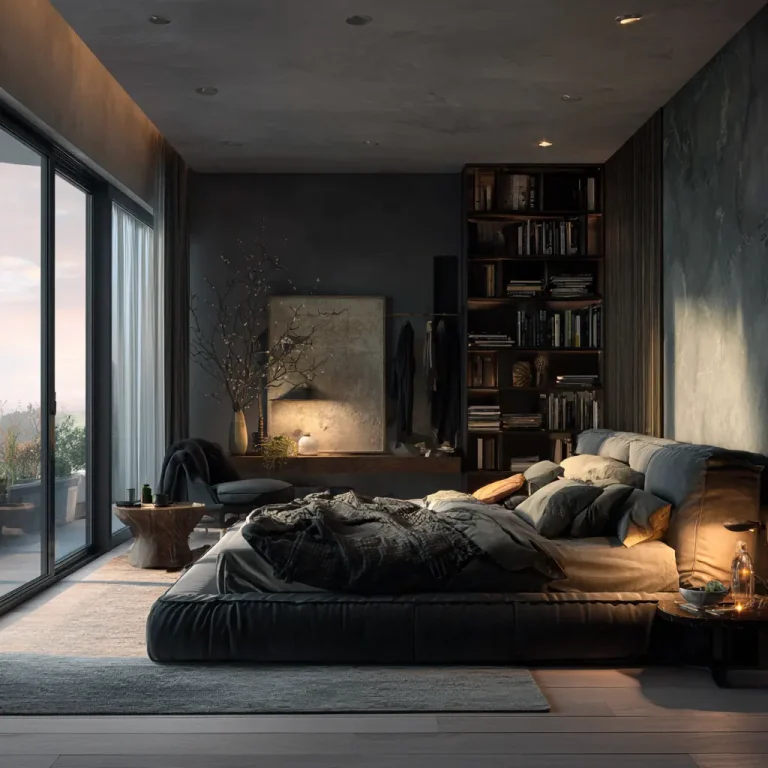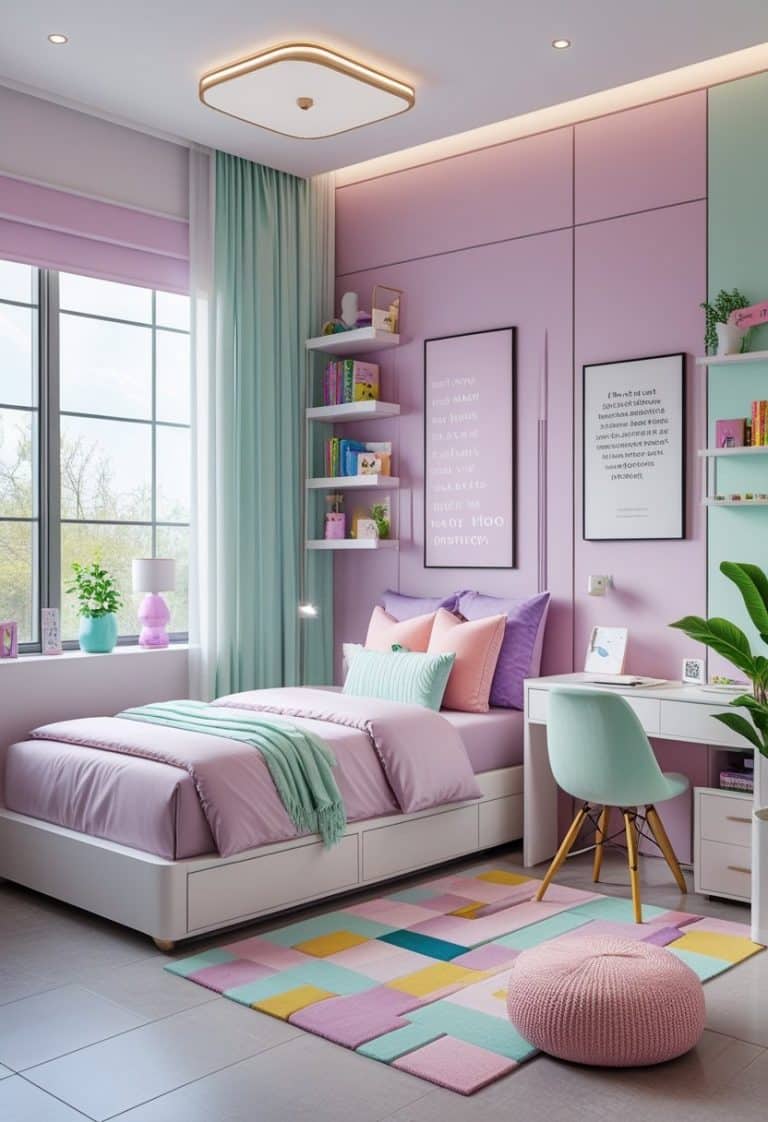20 Warm Bedroom Ideas 2025 For Cozy And Stylish Spaces

Creating a warm bedroom in 2025 focuses on comfort, style, and simple design choices that make a space feel inviting. Small details such as textures, colors, and lighting work together to transform a bedroom into a calm retreat that feels balanced and personal. The goal is to design a space that feels restful while still reflecting individual taste and modern trends.

This article explores practical ways to bring warmth into a bedroom using layers, natural materials, and thoughtful lighting. It highlights design principles that make a room feel cozy through every season while showing how small updates can create a lasting impact.
1) Layer plush duvets with soft throws

Layering a plush duvet with soft throws adds comfort and warmth to the bedroom. The mix of textures creates a relaxed and inviting look.
They can fold a throw at the foot of the bed or drape it across the side for a simple, stylish touch.
2) Use warm earthy tones like terracotta and ochre

Terracotta and ochre add natural warmth to a bedroom. These shades create a grounded look that feels calm and balanced.
They work well on walls, bedding, or accent pieces. Pairing them with soft neutrals or muted greens can keep the space inviting without feeling heavy.
3) Incorporate layered bedding for texture

Layered bedding adds depth and comfort to a bedroom. By combining different fabrics, the bed feels more inviting and visually balanced.
She can mix cotton sheets with a linen duvet and a wool throw. Adding a few pillows in varied sizes and materials creates subtle texture.
They may also use neutral tones for a calm look or add muted patterns for interest. This approach keeps the space warm and cohesive.
4) Add soft, textured rugs for warmth

A soft rug adds comfort underfoot and helps the room feel more inviting.
Textured designs, such as ribbed or shag styles, bring depth and visual interest.
Warm colors or subtle patterns can tie the room’s color scheme together while adding a layer of coziness.
5) Use warm ambient lighting with dimmers

Warm ambient lighting helps create a calm and inviting bedroom. Soft light reduces harsh shadows and makes the space feel more comfortable.
Dimmers give flexibility by letting them adjust brightness for reading, relaxing, or winding down at night. This simple change improves both mood and function.
6) Install wall sconces for cozy light

Wall sconces give soft, even lighting that reduces harsh shadows. They help make the bedroom feel calm and welcoming.
They also save space since they mount on the wall instead of taking up room on a nightstand.
Different designs fit both modern and traditional bedroom styles.
7) Choose wooden furniture with natural finishes

Wooden furniture with natural finishes adds warmth and texture to a bedroom. It highlights the grain and tone of the material without heavy stains or glossy coatings.
Pieces like oak bed frames, pine nightstands, or walnut dressers blend well with soft textiles and neutral colors, creating a calm and balanced space.
8) Add woven baskets for storage and texture

Woven baskets give bedrooms a practical way to store blankets, books, or small items. They reduce clutter while keeping essentials close.
Their natural texture adds warmth and depth to the room. Placing them under a nightstand or at the foot of the bed creates both function and style.
9) Use blackout curtains in warm colors

Blackout curtains in warm shades like beige, terracotta, or soft brown add comfort while blocking light.
They help regulate temperature, keeping the room cooler in summer and warmer in winter.
Choosing colors that match bedding or rugs creates a balanced and inviting look.
10) Incorporate plants for natural warmth

Plants add soft color and texture that make a bedroom feel more inviting. They bring a touch of nature indoors without overwhelming the space.
Simple choices like peace lilies, ferns, or small palms work well in corners or on bedside tables. Even one or two plants can create a warmer atmosphere.
11) Add a rustic wooden headboard

A rustic wooden headboard introduces natural texture and warmth to a bedroom. Its simple design pairs well with soft bedding and neutral tones.
Reclaimed or distressed wood adds character through visible grain and imperfections. This style works in both modern and farmhouse-inspired spaces.
They can choose lighter finishes for an airy look or darker tones for a cozier feel.
12) Use layered curtains for insulation

Layered curtains help reduce heat loss and block drafts around windows.
They often combine sheer panels with heavier fabrics like velvet, wool, or thermal-lined drapes.
This setup creates an extra barrier that improves insulation while also adding depth and style to the bedroom.
13) Include a fireplace or electric heater

A fireplace or electric heater adds steady warmth and creates a comfortable bedroom setting.
Electric options work well in smaller spaces since they need less maintenance and installation.
Traditional fireplaces can use stone or marble surrounds, while modern designs often feature sleek, recessed styles that blend with contemporary interiors.
14) Use warm metallic accents like copper

Copper accents bring a gentle glow that makes a bedroom feel inviting. They work well with both light and dark color palettes.
A copper lamp, mirror frame, or side table adds warmth without overwhelming the space. These details create balance and subtle visual interest.
15) Add plush velvet cushions

Plush velvet cushions bring a soft texture that makes a bedroom feel more comfortable. Their smooth surface adds a touch of elegance without overwhelming the space.
They work well on beds, chairs, or benches, offering both style and support. A few cushions in warm tones can easily enhance the room’s inviting look.
16) Incorporate soft knit blankets

Soft knit blankets add warmth and texture to a bedroom. Their simple design makes them easy to layer over bedding.
They work well in both modern and traditional spaces. Neutral tones create a calm look, while deeper shades can add contrast.
Placing one at the foot of the bed or draped over a chair keeps it functional and stylish.
17) Use warm pastel paint colors

Warm pastels create a gentle and inviting atmosphere in the bedroom. Soft shades like peach, blush, or muted coral add warmth without feeling heavy.
These colors pair well with natural light and simple furnishings. They help the room feel calm while still adding a touch of color.
18) Add fairy lights for subtle glow

Fairy lights create a soft and inviting atmosphere without overwhelming the space.
They work well along a headboard, around a mirror, or across a wall to add gentle warmth.
With different colors and styles available, they can match modern, boho, or minimal bedroom designs.
19) Choose warm-toned artwork

Warm-toned artwork can make a bedroom feel more inviting. Shades like terracotta, sienna, and amber bring a natural sense of comfort.
They work well with wood furniture, soft lighting, and textured fabrics. This creates a balanced and cohesive look.
Even a single piece of art can set the mood of the room.
20) Use natural fiber bedding like linen or cotton

Natural fiber bedding such as linen or cotton helps create a breathable and comfortable sleeping environment. These materials allow airflow and reduce heat buildup during the night.
They also offer a soft texture that feels inviting and cozy. Many people choose them for their durability and simple, timeless look.
Design Principles for a Warm Bedroom

A warm bedroom relies on intentional choices in color, texture, and lighting. Each element works together to create a space that feels calm, inviting, and comfortable without sacrificing style or function.
Color Psychology and Warmth
Color strongly influences how a bedroom feels. Warm tones such as terracotta, soft beige, muted gold, and earthy browns naturally create a sense of comfort. These shades reflect warmth and help the space feel more grounded.
She chose colors based on mood and purpose. For example, soft peach or clay tones encourage relaxation, while deeper shades like rust or cocoa add richness. Pairing warm neutrals with natural textures like wood or rattan enhances the effect.
A simple color guide can help:
| Color Family | Effect on Mood | Best Use |
|---|---|---|
| Earthy Neutrals | Calm, grounded | Walls, bedding |
| Warm Reds/Oranges | Cozy, energizing | Accent pillows, rugs |
| Golden Yellows | Uplifting, bright | Lighting accents, decor |
Balanced use of these tones prevents the room from feeling overwhelming while still maintaining warmth.
Layering Textiles for Comfort
Textiles add softness and depth to a bedroom. Layering different fabrics creates a tactile experience that makes the room feel inviting. Cotton sheets, linen duvets, wool throws, and velvet cushions each bring unique texture.
He used layering to add both comfort and flexibility. A lightweight quilt can stay year-round, while a chunky knit blanket provides extra warmth in colder months. Mixing smooth and textured fabrics prevents the room from looking flat.
Key combinations include:
- Base layer: breathable cotton or linen sheets
- Middle layer: quilt or coverlet for light warmth
- Top layer: wool or knit throw for texture
- Accent: velvet or faux fur pillows for softness
This approach ensures the room feels cozy without being cluttered.
Lighting Strategies for Coziness
Lighting shapes the mood of a bedroom more than most design elements. Warm-toned bulbs, typically in the 2700K–3000K range, create a soft glow that feels relaxing. Avoiding harsh white light helps maintain a restful atmosphere.
She arranged lighting in layers. A ceiling fixture provides general light, while bedside lamps or wall sconces add focused illumination for reading. String lights or LED strips tucked behind headboards can add subtle warmth.
Dimmers allow control over brightness, letting the room shift from practical use to a calming retreat. Combining multiple light sources ensures flexibility and keeps the space comfortable at any time of day.
Maintaining Warmth Throughout the Seasons

A bedroom can stay comfortable year-round with thoughtful bedding choices and the right materials. Adjusting layers and fabrics helps balance warmth in winter and breathability in summer while keeping the space inviting.
Seasonal Adjustments for Bedding
Bedding layers play a key role in regulating comfort across different seasons. In colder months, thicker duvets, quilted blankets, and flannel sheets provide insulation. Layering allows flexibility, so one can add or remove items as temperatures shift.
During warmer seasons, lightweight quilts, cotton sheets, and breathable throws reduce heat buildup. A mix of textures, such as linen paired with a thin coverlet, keeps the bed cozy without trapping excess warmth.
Some households use duvet inserts with varying weights that can be swapped out as needed. This system reduces storage needs and makes seasonal changes easier. Keeping extra blankets folded at the foot of the bed also ensures quick adjustments on cooler nights.
Key layering ideas:
- Winter: flannel sheets, wool blankets, heavy duvet
- Summer: cotton percale sheets, linen coverlet, light quilt
- Transitional months: medium-weight duvet with breathable cotton sheets
Climate-Appropriate Materials
Material choice affects how well a bedroom maintains warmth while staying comfortable. Natural fibers like wool and flannel retain heat effectively in winter. Wool also wicks moisture, which prevents overheating.
For warmer climates, linen and cotton are preferred. Linen is breathable and regulates temperature well, while cotton percale provides a crisp, cool feel. Both options allow airflow, making them suitable for hot nights.
Some households benefit from all-season bedding blends, such as cotton-wool mixes, which balance insulation and breathability. Synthetic materials like microfiber can trap heat, which may be useful in winter but less so in summer.
A simple comparison:
| Season | Best Materials | Benefits |
|---|---|---|
| Winter | Wool, flannel | Warmth, insulation, moisture control |
| Summer | Linen, cotton percale | Breathability, airflow, cooling |
| Year-round | Cotton-wool blends | Balance of warmth and comfort |






